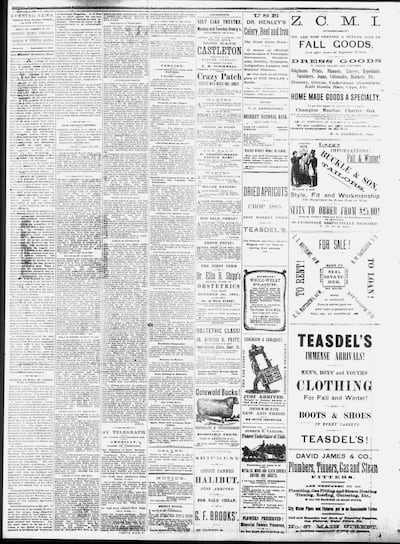- Chinese immigrants in Rock Springs were massacred 140 years ago in one of the worst atrocities in Wyoming's history.
- The town unveiled a new statue and intends to further build out the site of its former Chinatown.
- The mayor said he's proud his town is recognizing and learning from its past mistakes.
On Sept. 2, 1885, a population of Chinese coal miners were violently attacked by a mob of their neighbors in Rock Springs, Wyoming. At least 28 Chinese immigrants were killed, 15 others injured and 79 homes in the town’s Chinatown were burned to the ground.
On Tuesday, the town memorialized the 140-year-old atrocity, now called the “Rock Springs Massacre.” It’s one of the most violent moments in the state’s history, and among the worst race-based attacks in U.S. history.
After a six-day series of events and talks organized by local Chinese-Americans Grace and Ricky Leo commemorating the massacre, the town held a dedication ceremony at the original site of its Chinatown.
Rock Springs Mayor Max Mickelson said “it was a wonderful event,” and an opportunity to recognize the horrific moment from the town’s history, while also remaining willing to learn from past mistakes. That effort, he said, is built into the American experiment.
“Hopefully it is not political,” Mickelson said. “I’m a huge believer that America has always been great but not perfect, right? It’s a Constitution in search of ‘a more perfect Union,’ and so we learn from our history — good and bad — and then our goal is always to be better.”
Unveiling a new memorial
Approximately 200 people gathered — no small feat for the small Wyoming community — for the unveiling of the new statue. During the ceremony, several Rock Springs and neighboring town public officials gave remarks, as did retired Army Major Gen. Robert G.F. Lee, who presented the Congressional Gold Medal to Jennifer Messer, curator of the Rock Springs Historical Museum.
There are few in Rock Springs who were not supportive of the effort, the mayor said, noting one city councilman who called it “an egregious waste of money.” But overall the organizers and town officials have received support from the local community.
“We have had a dozen businesses and more than 50 individuals and associations donate to date,” Messer wrote in an email. “Since the unveiling we have had a flood of new brick purchases and offers of contributions and collaborations.”

The statue now sits at the edge of an archaeological site, flanked by a church and a local school. Researchers from Grinnell College in Iowa are digging into the earth, studying what can be pieced together from the remnants of the massacre’s burn scar left underground.
Attendees at the ceremony were shown the site and remnants of what archaeologists have found.
The new statue, itself, is called the “Requiem” and stands 7 feet tall. It depicts a Chinese miner, holding representations of some of those same unearthed artifacts. They were scanned, enlarged and included in the design of the statue, which replaces a simple plaque that used to be the sole mention in town recognizing its brutal history.
Now, Rock Springs will continue to build out the park and location of the massacre, and turn it into something that the mayor believes the whole community can be proud of.
“I fully believe that America is the greatest country on earth, and it’s OK to acknowledge that we’ve not always done things well,” said Mickelson. “We’ve had some real missteps and they have educated us and helped us to be more morally straight.”
What is the Rock Springs Massacre?
The “Rock Springs Massacre” was the result of long-simmering tensions in the community, the broader territory of Wyoming as well as the entire western United States in the years following the Gold Rush.
Many Chinese immigrants had arrived into the port of San Francisco lured by the promise of work and gold, and ultimately moved inland. The tensions arose as the Chinese immigrants looked for work in the same places where European-descended Americans were expanding the country westward.

This tension predated and potentially led to the first-ever immigration reform signed into law by the U.S. government: The Chinese Exclusion Act of 1882.
But before that was signed into law, the coal miners in Wyoming along the transcontinental railroad went on strike in 1879. As a result, the mine owners hired Chinese workers to cross the picket line and work for lower wages.
Then a fight broke out between the Chinese and Wyoming miners in shaft No. 6 in Rock Springs and the violence, which killed one Chinese worker, spilled up above ground and into the town itself.
Remembering the past
Rock Springs has not shied away from its history but rather remembered and considered it a learning opportunity for the community.
“Our local school district teaches about the Chinese massacre when they do their history of Rock Springs unit,” Mickelson said. “They’re planning on bringing students every year down to the park.”
For one Wyoming legislator, the recognition in Rock Springs is a hopeful sign for the state and for the country in general.

“It’s a good reflection on the progress our country has made, that going from something like the Rock Springs massacre 140 years ago to having a state legislator who is Chinese American sit in the House of Representatives for the state,” said Mike Yin, the only Chinese American representative in Wyoming state government.
And being close to Labor Day, his reflection also comes with a warning about the value of work and community.
“It’s a reminder that labor shouldn’t be divided and communities shouldn’t be divided,” Yin said. “When you divide a labor movement or you divide a community, (the Rock Springs Massacre) is an example of what could happen as a result.”


